The important parts of the thoracic spine include:
- bones and joints
- nerves
- connective tissues
- muscles
- spinal segments
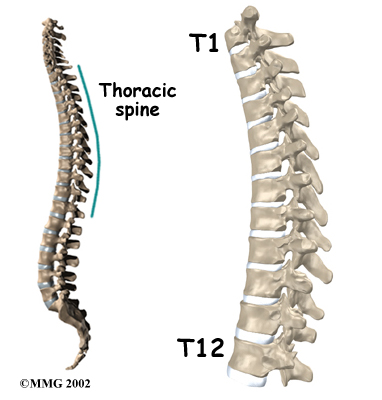
This section highlights important structures in each category.
Bones and Joints
The human spine is made up of 24 spinal bones, called vertebrae. Vertebrae are stacked on top of one another to create the spinal column. The spinal column is the body's main upright support.
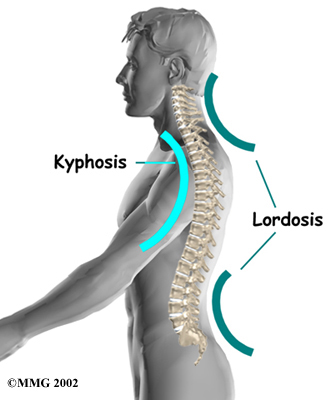 From the side, the spine forms three curves. The neck, called the cervical spine, curves slightly inward. The thoracic spine curves outward. The low back, also called the lumbar spine, curves slightly inward. An inward curve in the spine is called a lordosis. An outward curve, as in the thoracic spine, is called a kyphosis. A kyphosis is shaped like a "C" with the opening at the front.
From the side, the spine forms three curves. The neck, called the cervical spine, curves slightly inward. The thoracic spine curves outward. The low back, also called the lumbar spine, curves slightly inward. An inward curve in the spine is called a lordosis. An outward curve, as in the thoracic spine, is called a kyphosis. A kyphosis is shaped like a "C" with the opening at the front.
The middle 12 vertebrae make up the thoracic spine. Doctors often refer to these vertebrae as T1 to T12. The first large bump on the back of the lower part of the neck as you feel down your spine is the seventh cervical vertebra, called C7. It sits on top of T1, the next large bump. The lowest vertebra of the thoracic spine, T12, connects below the bottom of the rib cage to the first vertebra of the lumbar spine, called L1.
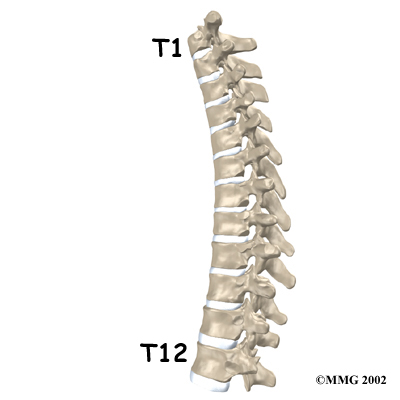 Each vertebra is made up of the same parts. A round block of bone, called the vertebral body, forms the main section of each thoracic vertebra from T1 to T12. Each vertebra increases slightly in size from the neck down. The increased size helps balance and support the larger muscles that connect to the lower parts of the spine.
Each vertebra is made up of the same parts. A round block of bone, called the vertebral body, forms the main section of each thoracic vertebra from T1 to T12. Each vertebra increases slightly in size from the neck down. The increased size helps balance and support the larger muscles that connect to the lower parts of the spine.
A bony ring attaches to the back of each vertebral body. This protective ring of bone surrounds the spinal cord, forming the spinal canal. Two bony extensions called pedicles connect directly to the back of the vertebral body. Two laminae join the pedicles to complete the ring. The laminae form the outer portion of the bony ring. When the vertebrae are stacked on top of each other, this bony ring forms a hollow tube that surrounds the spinal cord and nerves. The laminae provide a protective roof over these nerve tissues.
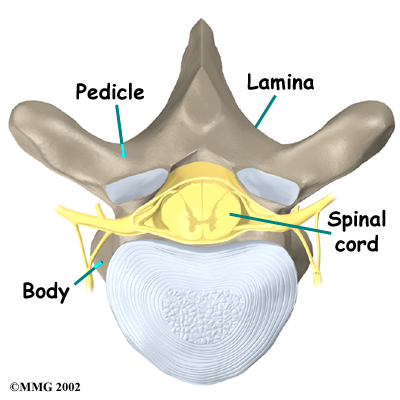
A bony knob projects out at the point where the two laminae join together at the back of the spine. You can feel these projections, called spinous processes, as you rub your fingers up and down the middle of your back. Bony knobs also project out from the side of the bony ring, one on the left and one on the right. These projections are called transverse processes. In the thoracic spine, all the ribs except the 11th and 12th ones attach onto these transverse processes as well as attaching onto the thoracic vertebral body. The 11th and 12th ribs connect only to the vertebral body and are therefore freer to move.
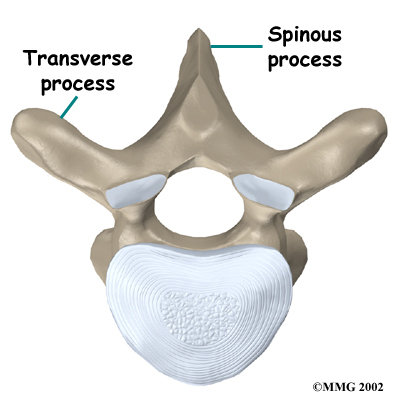 Between the vertebrae of each spinal segment are two facet joints. The facet joints are located on the back of the spinal column. There are two facet joints between each pair of vertebrae, one on each side of the spinous process. The alignment of the facet joints of the thoracic spine allows freedom of movement as you twist, move back and forth, or lean side to side.
Between the vertebrae of each spinal segment are two facet joints. The facet joints are located on the back of the spinal column. There are two facet joints between each pair of vertebrae, one on each side of the spinous process. The alignment of the facet joints of the thoracic spine allows freedom of movement as you twist, move back and forth, or lean side to side.
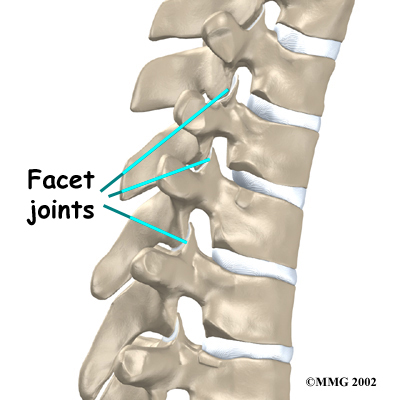
The surfaces of the facet joints are covered by articular cartilage. Articular cartilage is a slick, rubbery material that covers the ends of the bones in a joint. The cartilage allows the bones to move against each other smoothly, without friction.
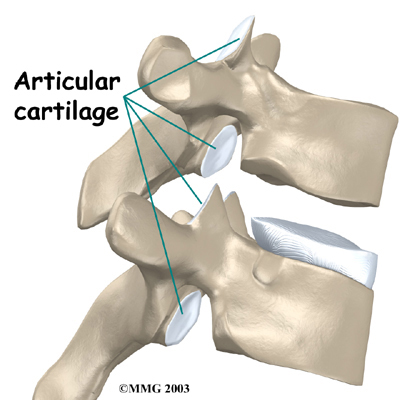
On the left and right side of each vertebra a small tunnel is formed from the stacking of vertebrae. This is called a neural foramen. (Foramina is the plural term.) The two nerves that leave the spine at each vertebra go through the foramina, one on the left and one on the right. The intervertebral disc (described later) sits directly in front of the opening. A bulged or herniated disc can encroach on the opening and put pressure on the nerve. A facet joint sits in the back of the foramen on each side.
Bone spurs that form on the facet joints can also encroach into the space of the foramen, narrowing the hole and pinching the nerve.
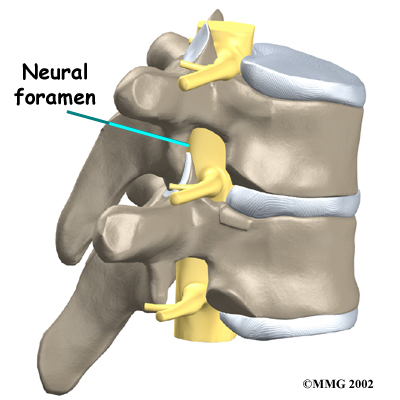 Nerves
Nerves
The hollow tube formed by the bony rings on the back of the spinal column surrounds the spinal cord. The spinal cord is like a long wire made up of millions of nerve fibers. Just as the skull protects the brain, the bones of the spinal column protect the spinal cord.
The spinal cord travels down from the brain through the spinal column. In the thoracic spine, the spinal canal is narrower than in the rest of the spine, so there is very little extra space for the spinal cord as it passes through this area. Due to this, thoracic spine injuries involving the spinal cord are often more problematic than in other areas of the spine.
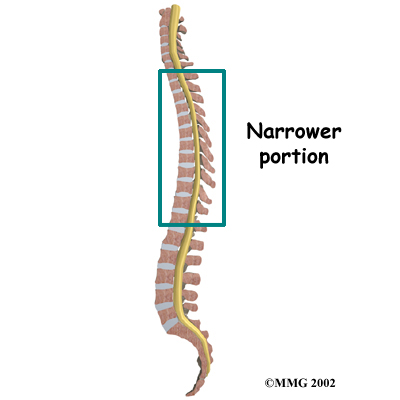
Between the vertebrae of the entire spine, including the thoracic spine, two large nerves branch off the spinal cord, one on the left and one on the right. The nerves pass through the neural foramina of each vertebra. These spinal nerves group together to form the main nerves that innervate the organs and limbs. The nerves originating from the thoracic spine mainly control the muscles and organs of the chest and abdomen.
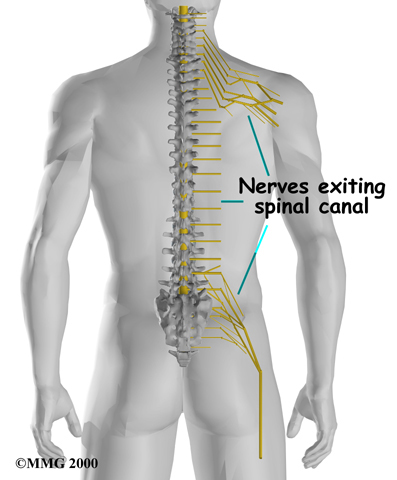 Connective Tissue
Connective Tissue
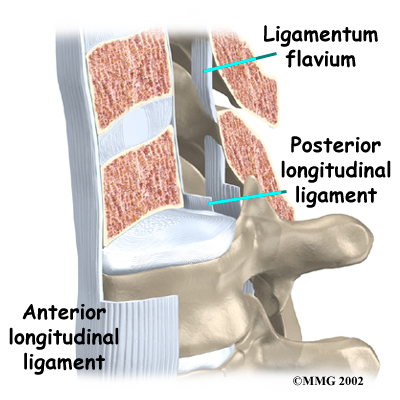 Connective tissue is a network of fiber that holds the cells of the body together. Ligaments are strong connective tissues that attach bones to other bones to hold them in place. Several long ligaments connect on the front and back sections of the vertebrae of the entire spine, including the thoracic spine. The anterior longitudinal ligament runs lengthwise down the front of the vertebral bodies. Two other ligaments run the full length within the spinal canal. The posterior longitudinal ligament attaches on the back of the vertebral bodies. The ligamentum flavum is a long and more elastic-like ligament that connects to the front surface of the lamina area of the vertebrae. Thick ligaments also connect the ribs to the transverse processes of the thoracic spine.
Connective tissue is a network of fiber that holds the cells of the body together. Ligaments are strong connective tissues that attach bones to other bones to hold them in place. Several long ligaments connect on the front and back sections of the vertebrae of the entire spine, including the thoracic spine. The anterior longitudinal ligament runs lengthwise down the front of the vertebral bodies. Two other ligaments run the full length within the spinal canal. The posterior longitudinal ligament attaches on the back of the vertebral bodies. The ligamentum flavum is a long and more elastic-like ligament that connects to the front surface of the lamina area of the vertebrae. Thick ligaments also connect the ribs to the transverse processes of the thoracic spine.
A special type of structure in the spine called an intervertebral disc is also made up of connective tissue. Special cells, called collagen cells, form the fibers of the disc. The fibers may be lined up like strands of nylon rope or crisscrossed like a net.
An intervertebral disc is made up of two parts. The center, called the nucleus pulposus, is spongy. It provides most of the shock absorption in the spine. The nucleus is held in place by the annulus, a series of strong ligament rings surrounding the nucleus. If there is wear and tear or injury to the annulus, the inner nucleus can bulge out causing pain and can also irritate the nerves located nearby.
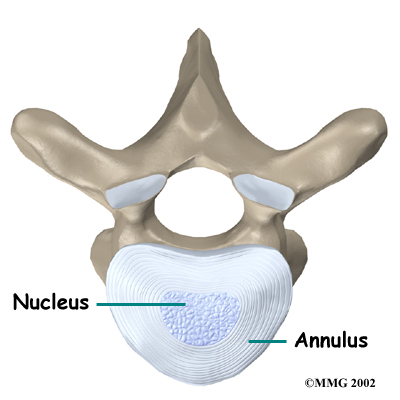
Discs in the thoracic spine are much thinner than in the cervical and lumbar spine. As a result, there is generally less movement between the vertebrae of the thoracic spine and less frequent bulging of the discs compared to the cervical or lumbar spine.
Muscles
The muscles of the thoracic spine are arranged in layers. Those closest to the skin's surface run from the back of the vertebrae to the shoulder blades. Others wrap around the rib cage and connect to the shoulders. Strap-shaped muscles called erector spinae make up the middle layer of muscles. These muscles run up and down over the lower ribs and thorax (the rib cage), and cross to the low back. The deepest layer of muscles attaches along the back of the spine bones, connecting each vertebrae together. Muscles also connect from one rib to the next. The muscles of the thoracic spine have many functions including moving the thorax, as well as assisting in trunk stability.
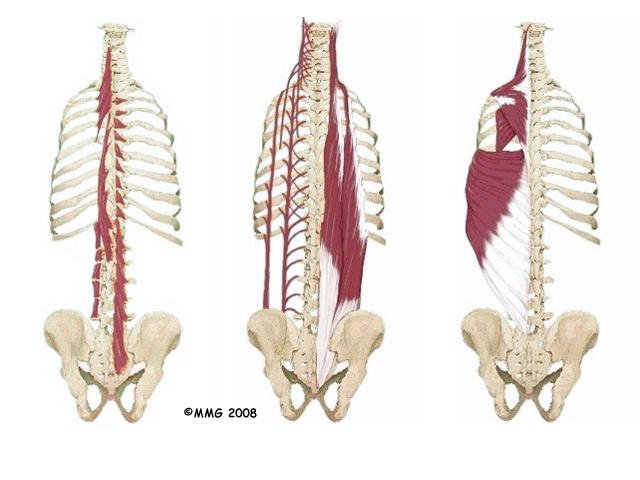
Spinal Segment
A good way to understand the anatomy of the thoracic spine is to visualize one spinal segment in relation to the anatomy described above. Each spinal segment includes two vertebrae separated by an intervertebral disc, the nerves that leave the spinal column at each vertebra, and the small facet joints that link each level of the spinal column.
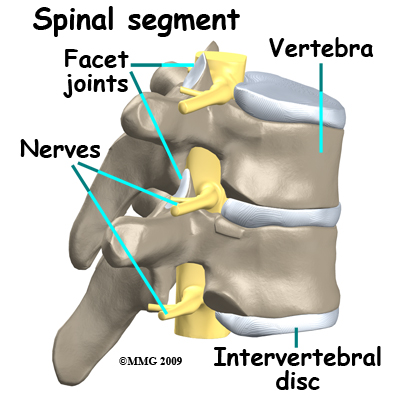
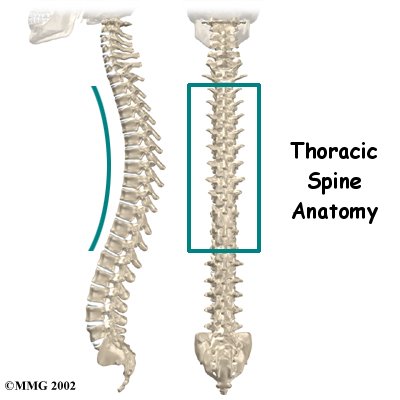


 From the side, the spine forms three curves. The neck, called the cervical spine, curves slightly inward. The thoracic spine curves outward. The low back, also called the lumbar spine, curves slightly inward. An inward curve in the spine is called a lordosis. An outward curve, as in the thoracic spine, is called a kyphosis. A kyphosis is shaped like a "C" with the opening at the front.
From the side, the spine forms three curves. The neck, called the cervical spine, curves slightly inward. The thoracic spine curves outward. The low back, also called the lumbar spine, curves slightly inward. An inward curve in the spine is called a lordosis. An outward curve, as in the thoracic spine, is called a kyphosis. A kyphosis is shaped like a "C" with the opening at the front. Each vertebra is made up of the same parts. A round block of bone, called the vertebral body, forms the main section of each thoracic vertebra from T1 to T12. Each vertebra increases slightly in size from the neck down. The increased size helps balance and support the larger muscles that connect to the lower parts of the spine.
Each vertebra is made up of the same parts. A round block of bone, called the vertebral body, forms the main section of each thoracic vertebra from T1 to T12. Each vertebra increases slightly in size from the neck down. The increased size helps balance and support the larger muscles that connect to the lower parts of the spine.
 Between the vertebrae of each spinal segment are two facet joints. The facet joints are located on the back of the spinal column. There are two facet joints between each pair of vertebrae, one on each side of the spinous process. The alignment of the facet joints of the thoracic spine allows freedom of movement as you twist, move back and forth, or lean side to side.
Between the vertebrae of each spinal segment are two facet joints. The facet joints are located on the back of the spinal column. There are two facet joints between each pair of vertebrae, one on each side of the spinous process. The alignment of the facet joints of the thoracic spine allows freedom of movement as you twist, move back and forth, or lean side to side.

 Nerves
Nerves
 Connective Tissue
Connective Tissue Connective tissue is a network of fiber that holds the cells of the body together. Ligaments are strong connective tissues that attach bones to other bones to hold them in place. Several long ligaments connect on the front and back sections of the vertebrae of the entire spine, including the thoracic spine. The anterior longitudinal ligament runs lengthwise down the front of the vertebral bodies. Two other ligaments run the full length within the spinal canal. The posterior longitudinal ligament attaches on the back of the vertebral bodies. The ligamentum flavum is a long and more elastic-like ligament that connects to the front surface of the lamina area of the vertebrae. Thick ligaments also connect the ribs to the transverse processes of the thoracic spine.
Connective tissue is a network of fiber that holds the cells of the body together. Ligaments are strong connective tissues that attach bones to other bones to hold them in place. Several long ligaments connect on the front and back sections of the vertebrae of the entire spine, including the thoracic spine. The anterior longitudinal ligament runs lengthwise down the front of the vertebral bodies. Two other ligaments run the full length within the spinal canal. The posterior longitudinal ligament attaches on the back of the vertebral bodies. The ligamentum flavum is a long and more elastic-like ligament that connects to the front surface of the lamina area of the vertebrae. Thick ligaments also connect the ribs to the transverse processes of the thoracic spine.



